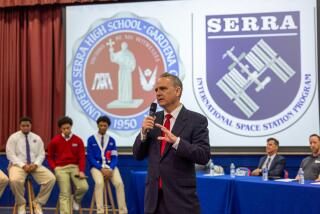Oxnard Students Get an Up-Close Look at Out-of-This-World Exhibit : Science: Elementary school class peers through microscope at moon rocks and soil on loan from the National Aeronautics and Space Administration.
- Share via
For 11-year-old Michael Gonzales, looking at moon rocks and soil through a microscope may be the closest he will ever get to the stars.
*
But he is closer than the thousands of children who will never see the hard-to-obtain samples of extraterrestrial rocks and soil.
“I don’t think I’ll ever forget it,” said Michael, a sixth-grader at Elm Street School in Oxnard, as he gazed at the rocks.
Schools throughout the country wait as long as a year to be able to borrow the moon rocks and soil for a two-week period from the National Aeronautics and Space Administration, said Garth Hull, chief of NASA’s Educational Program Office for 11 Western states.
Hull said his office at Moffett Field in Mountain View, Calif., has 20 sets of lunar rocks and soil it loans to schools in the 11 Western states.
“It’s a rare opportunity for children . . . to see moon rocks and soil,” Hull said. “For every child who looks at moon rocks under a microscope, there are millions who will never have that chance.”
Ruth Toops, Michael’s teacher, said the lunar items have stirred excitement among her students.
“This experience has expanded their knowledge and widened their expectations of themselves and the world around them,” Toops said. “We feel privileged that we have been able to have the moon rocks.”
*
NASA requires that teachers who get the rocks become certified by taking a NASA seminar on matters involving the moon.
“It’s a popular program, and before we send anything out, we want to make sure that the teacher has knowledge and appreciation for the moon,” Hull said.
Toops, who took the seminar four years ago in Texas, said she is the only NASA-certified teacher in the Oxnard Elementary School District. She also said this is the first time the district has been able to borrow the extraterrestrial components.
After Toops received the rocks, her class of 18 students served as host to other students who wanted to learn about moon rocks.
During a recent three-hour class, students watched a video on manned trips to the moon and then asked questions.
They learned that the moon is roughly 240,000 miles from the Earth and that some scientists believe it was created more than 4 billion years ago when a huge space rock hit Earth and parts of it became the moon.
*
After the seminar, students lined up by the microscope to observe the three moon rocks and three samples of moon soil stored inside a clear plastic disc.
“I can’t believe these rocks are really from the moon,” 11-year-old Anthony Torres said. “It has orange soil. I always thought the moon was gray.”
Toops said she also took the disc to several other schools to allow students elsewhere in the district to expand their horizons.
“Once they see the moon rocks and soil, they want to know everything,” Toops said. “They want to know how many times men have gone to the moon, and why there was never a woman on the missions.”
More to Read
Sign up for Essential California
The most important California stories and recommendations in your inbox every morning.
You may occasionally receive promotional content from the Los Angeles Times.










